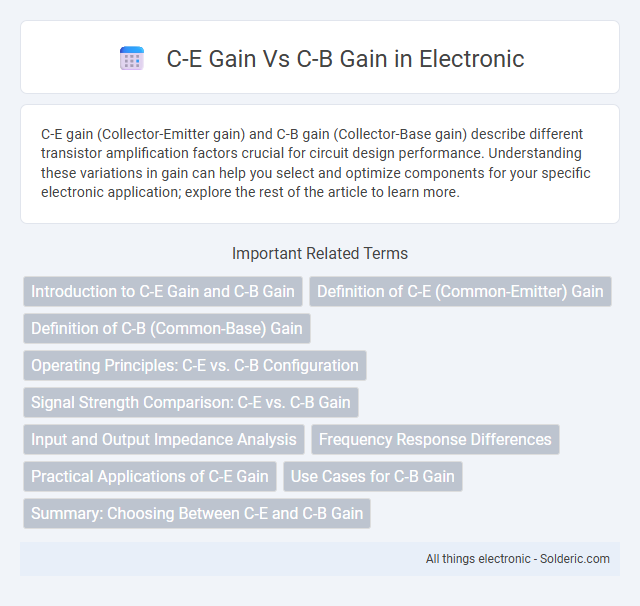C-E gain (Collector-Emitter gain) and C-B gain (Collector-Base gain) describe different transistor amplification factors crucial for circuit design performance. Understanding these variations in gain can help you select and optimize components for your specific electronic application; explore the rest of the article to learn more.
Comparison Table
| Parameter | C-E Gain (Common-Emitter) | C-B Gain (Common-Base) |
|---|---|---|
| Voltage Gain | High | Moderate to High |
| Current Gain | High (b or hFE) | Low (1) |
| Input Impedance | Moderate (kO range) | Low (100s O) |
| Output Impedance | High | Moderate |
| Phase Shift | 180deg | 0deg |
| Common Applications | Voltage amplification, general purpose amplifiers | High-frequency applications, impedance matching |
Introduction to C-E Gain and C-B Gain
C-E gain (Common-Emitter gain) and C-B gain (Common-Base gain) refer to the amplification factors in bipolar junction transistors, crucial for designing amplifier circuits. The C-E configuration provides high voltage and current gain, making it suitable for general amplification, while the C-B configuration offers low input impedance but high voltage gain with minimal current gain, often used in high-frequency applications. Understanding these distinctions helps optimize Your circuit's performance based on gain requirements and frequency response.
Definition of C-E (Common-Emitter) Gain
Common-Emitter (C-E) gain refers to the amplification factor of a transistor configuration where the emitter terminal is common to both input and output circuits, characterized by high voltage and current gain. The C-E gain is mainly defined as the ratio of the output current or voltage to the input current or voltage, providing significant signal amplification in bipolar junction transistors (BJTs). This configuration contrasts with Common-Base (C-B) gain, which generally exhibits lower input impedance and voltage gain but higher frequency response.
Definition of C-B (Common-Base) Gain
Common-Base (C-B) gain refers to the voltage amplification achieved when the base terminal of a transistor is common to both input and output circuits, serving as a fixed reference point. This configuration typically exhibits low input impedance and high voltage gain, making it suitable for high-frequency applications. Understanding C-B gain allows you to optimize transistor performance where stability and bandwidth are critical.
Operating Principles: C-E vs. C-B Configuration
The Common-Emitter (C-E) configuration provides high voltage and power gain by using the emitter as a common terminal, allowing the input signal applied at the base to control a larger current at the collector. In contrast, the Common-Base (C-B) configuration offers low input impedance and voltage gain but provides high current gain with the base terminal as common, making it ideal for high-frequency applications. Understanding these operating principles helps you select the appropriate amplifier configuration based on gain requirements and signal characteristics.
Signal Strength Comparison: C-E vs. C-B Gain
C-E (Collector-Emitter) gain typically exhibits higher voltage amplification compared to C-B (Collector-Base) gain due to the emitter's role in controlling input current, resulting in increased signal strength. The common-emitter configuration often achieves voltage gains ranging from 50 to 200, significantly surpassing the common-base gain, which is generally close to unity (around 1). Signal strength in C-E gain circuits improves with load resistance and transistor beta (b), while C-B gain maintains low input impedance and is preferred for high-frequency applications despite its lower amplification.
Input and Output Impedance Analysis
C-E (Common-Emitter) gain offers moderate input impedance and high output impedance, making it suitable for voltage amplification. C-B (Common-Base) gain features low input impedance and low output impedance, enabling better performance in high-frequency applications. You should choose the configuration based on whether impedance matching or voltage amplification is your priority.
Frequency Response Differences
C-E gain (common-emitter) circuits typically offer higher gain but exhibit a more limited frequency response compared to C-B gain (common-base) configurations, which provide lower gain but superior high-frequency performance. The common-base arrangement minimizes input capacitance effects, enabling better stability and bandwidth at gigahertz frequencies, crucial for RF amplifier design. Understanding these frequency response differences helps you select the optimal transistor configuration for your high-speed electronics applications.
Practical Applications of C-E Gain
C-E gain (Common-Emitter gain) is widely used in amplifier circuits due to its high voltage gain and phase inversion capabilities, making it ideal for audio amplification and signal processing applications. Compared to C-B gain (Common-Base gain), C-E gain offers higher input impedance, which ensures better coupling with preceding circuit stages while maintaining significant voltage amplification. Practical applications of C-E gain include designing mid-frequency amplifiers in radio receivers, operational amplifier input stages, and interfacing sensors where moderate to high voltage gain is required.
Use Cases for C-B Gain
C-B gain excels in applications requiring stable voltage amplification with high input impedance, such as in voltage amplifiers and impedance buffering. Its low input impedance and high output impedance make it less suitable for direct signal sources but ideal for cascaded amplifier stages where voltage gain consistency is critical. You benefit from using C-B gain in high-frequency circuits and RF amplifiers where isolation between input and output is necessary to minimize feedback and enhance signal integrity.
Summary: Choosing Between C-E and C-B Gain
C-E gain typically offers higher voltage amplification and better frequency response, making it ideal for audio and high-frequency applications, while C-B gain provides lower input capacitance and increased bandwidth suitable for RF and high-speed circuits. C-E gain configurations yield larger voltage gains but tend to have higher input resistance and moderate output resistance, whereas C-B gain boasts low input impedance and higher output impedance. Selecting between C-E and C-B gain depends on the trade-off between voltage gain, bandwidth, input/output impedance, and the specific requirements of the electronic circuit.
C-E gain vs C-B gain Infographic

 solderic.com
solderic.com